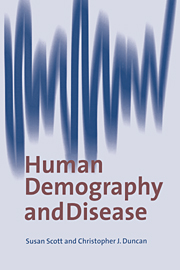Book contents
- Frontmatter
- Contents
- Preface
- Conversion table for imperial to metric units
- 1 Introduction
- 2 Tools for demography and epidemiology
- 3 Identification of population oscillations: a case study
- 4 Density-dependent control and feedback
- 5 Modelling the endogenous oscillations and predictions from timeseries analysis
- 6 Cycles in the grain price series
- 7 Interactions of exogenous cycles: a case study
- 8 Mortality crises and the effects of the price of wool
- 9 Modelling epidemics for the demographer: the dynamics of smallpox in London
- 10 Non-linear modelling of the 2-yearly epidemics of smallpox: the genesis of chaos?
- 11 Measles and whooping cough in London
- 12 Integration of the dynamics of infectious diseases with the demography of London
- 13 Smallpox in rural towns in England in the 17th and 18th centuries
- 14 Infectious diseases in England and Wales in the 19th century
- 15 Prospectives – towards a metapopulation study
- References
- Index
9 - Modelling epidemics for the demographer: the dynamics of smallpox in London
Published online by Cambridge University Press: 25 January 2010
- Frontmatter
- Contents
- Preface
- Conversion table for imperial to metric units
- 1 Introduction
- 2 Tools for demography and epidemiology
- 3 Identification of population oscillations: a case study
- 4 Density-dependent control and feedback
- 5 Modelling the endogenous oscillations and predictions from timeseries analysis
- 6 Cycles in the grain price series
- 7 Interactions of exogenous cycles: a case study
- 8 Mortality crises and the effects of the price of wool
- 9 Modelling epidemics for the demographer: the dynamics of smallpox in London
- 10 Non-linear modelling of the 2-yearly epidemics of smallpox: the genesis of chaos?
- 11 Measles and whooping cough in London
- 12 Integration of the dynamics of infectious diseases with the demography of London
- 13 Smallpox in rural towns in England in the 17th and 18th centuries
- 14 Infectious diseases in England and Wales in the 19th century
- 15 Prospectives – towards a metapopulation study
- References
- Index
Summary
It was shown in Chapter 7 that infant deaths made a major contribution to the overall mortality at Penrith. It is possible to determine infant mortality in the 16th and 17th centuries only by family reconstitution techniques, and such studies are necessarily confined to relatively small populations. Lifetable burial series for the community at Penrith in successive cohorts are shown in Table 7.1 and it can be seen that infant mortality declined progressively in the 17th and 18th centuries, but child (age 1 to 14 years) mortality correspondingly increased. This was because of the spread of a lethal, infectious disease, smallpox, as suggested in section 7.3.2, and we show in this chapter that it was a major factor in determining mortality patterns and the demography of England in the 17th, 18th and 19th centuries.
There are reasons to believe that smallpox as a human disease was of great antiquity; lesions on the mummified face of Rameses V, dated 1160 BC, suggest that he died of smallpox (Dixon, 1962) and the disease is first clearly described by the Persian physician, Rhazes, in about AD 900 (Kahn, 1963). It was spread through Europe by the Saracen invaders and by the returning Crusaders. The Spaniards took smallpox with them to the West Indies in 1507 and to Mexico in 1520, decimating the Indian population (Cliff & Haggett, 1988).
Smallpox was apparently rarely lethal in England until the 1630s (Appleby, 1981), and many accounts suggest that a particularly virulent strain began to afflict people at that time (Corfield, 1987) with a gradual but significant increase in the case fatality rate (Razzell, 1977).
- Type
- Chapter
- Information
- Human Demography and Disease , pp. 169 - 188Publisher: Cambridge University PressPrint publication year: 1998



